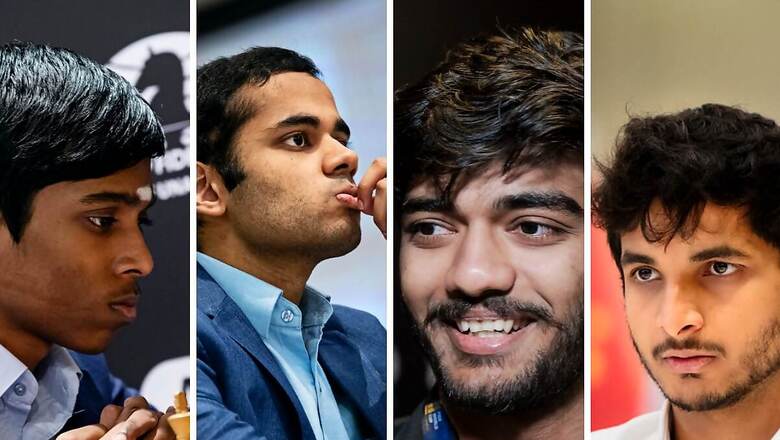
views
Four Indians, among them three teenagers, have made it to the quarterfinals of the FIDE World Cup 2023, signalling a chess renaissance in the country which birthed the game.
This World Cup is not the biggest tournament in chess— it’s the FIDE Candidates tournament. Eight players can play and the winner will then be given a chance to challenge the reigning World Champion, China’s Ding Liren. Vishwanathan Anand is the only Indian to have made it to the Candidates tournament before.
‘Chaturanga’ is said to have originated during the Gupta Dynasty, and later became popular worldwide under various names. Today it is a global sport played in 172 countries. But modern India’s chess journey did not take a transformative turn until Viswanathan Anand clinched the Grandmaster title in 1988.
A Slew of Prodigies
Since then, India has produced 81 more in just three decades. Indian youngsters have consistently performed well in World Youth and Junior Championships across various age categories, showcasing the depth of young talent in the country.
With continued support, India could soon challenge and surpass chess giants like the U.S. and Russia. As Viswanathan Anand notes in this article, “The trickle has turned into a flood. First, there was a slew of youngsters becoming grandmasters, then we saw the signs of maturity and staying power at the Chess Olympiad, and now we are seeing it in the performances at the Chess World Cup too. The golden generation of Indian chess, led by D Gukesh and R Praggnanandhaa, but also made up of so many other promising young people, is starting to truly make its mark on the world stage. They are going to keep scaling new heights.”
Grandmasters like Anand have played a pivotal role in popularising the game. There can be no higher testimony to India’s emergence as a chess superpower than the fact that Anand himself has been beaten at the game by a prodigy.
Gukesh Beats Anand…: 17-year-old D Gukesh overtook Vishwanathan Anand as the highest-ranking Indian in FIDE rankings this year. Anand has been India’s top-ranked player since 1987.
Gukesh is the second-youngest grandmaster and the youngest Indian to achieve this feat. He now stands 9th in the FIDE list for August and at No. 7 in the live world rankings.
After his defeat, Anand is quoted as saying, “Even though I have been semi-retired for a couple of years, still to lose a spot you have held for 37 years is, well it’s historic, I have to admit that.
And Carlssen Too…: A year ago, Gukesh had made headlines by beating World Champion Magnus Carlssen of Norway. But then, Gukesh is not the only one. Rameshbabu Pragnananda has beaten Carlsen already.
India’s 2020 Gold: India were awarded the Chess Olympiad gold medal jointly with Russia after a frantic finish. That team had young grandmasters like D Harika, Nihal Sarin, Vidith Gujarathi and Divya Deshmukh.
When Modi Brought Chess to Schools
The perception in India about chess has shifted from being just a pastime to a serious competitive sport. This is thanks to the strong encouragement extended by the government.
Starting Young: In 2009, as Gujarat CM, Narendra Modi made Chess mandatory in schools. This after she learned during a visit to Azerbaijan that students there were sharper than in other erstwhile Soviet republics, as “the mantra was their mass initiation into chess at a very young age”.
Chess is taught as a school subject in Armenia and Azerbaijan. India has also tried to emulate this in some states. In Rajasthan, chess was taught as a compulsory subject for one month in 2022. Gujarat was the first state to introduce chess as part of the school curriculum, followed by Tamil Nadu.
Training Harder: Financial support and recognition from both the government and private entities have encouraged more players to pursue chess as a professional career.
Anand’s own Westbridge Chess Academy has been an inspiration for many young players. The academy has helped D Gukesh navigate the complex world of professional chess. The All India Chess Federation has opened several training centres and academies, the latest one in Odisha.
The rise of online chess platforms has made it easier for players to practice, compete, and learn from players around the world without geographical constraints.
Competing More: India has hosted the 180-nation Chess Olympiad in 2022 in Chennai with a $10 million budget. This grand event showed India’s sporting ambition and its rising global status.
Chennai holds the crown as the Chess capital of India as it hosts several academies. The city has hosted national and international chess tournaments including the World Chess Championship match between Viswanathan Anand and Magnus Carlsen in 2013, which garnered global attention.
But India needs chess to be popularised across other cities with more tournaments and international events held across the country.
The Gender Gap: Koneru Humpy and Harika D. are the only two female grandmasters from India so far and the last one was in 2011. More efforts are being made to break that barrier. There are 25 Woman Grandmasters from India as of now. Koneru Humpy has pitched for more chess tournaments in India for women and girls.
FUN FACT: Amritsar’s Connection with Global Chess
For the global chess community, Amritsar is the source of the world’s finest wooden chess pieces. World-class chess pieces fly every year from Amritsar’s workshops to the US, UK, EU etc. Globally, chess tournaments are played exclusively with wooden pieces. The handful of chess-piece manufacturers in Amritsar takes pride in asserting that no one in the world can match their unique artistry in designing, shaping, and crafting wooden chess pieces – a different kind of novelty in the chess world.















Comments
0 comment